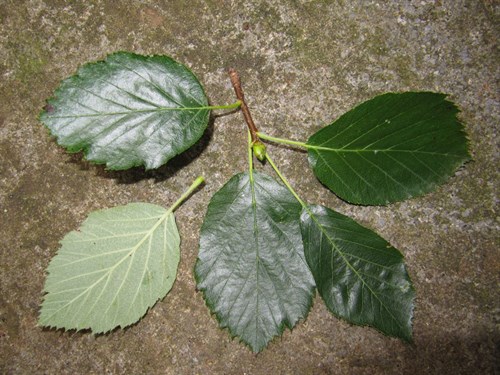Old newspapers have been an unexplored resource for botanical information (and many other things). Access to them has been difficult and finding anything of use takes time. It is useful if there are regular articles about a subject as they can stand out in each edition but even a weekly newspaper will have 52 editions a year. Some have been filmed onto microfiche and film, and are a little easier, quicker, and cleaner to look through. Recently the British Library has started to digitise its archive of newspapers making digitised copies available.
Researching anything in newspapers is now possible and it is possible to restrict the search by date, title and county depending on the required results. The technology relies on the newspaper print being recognisable. Due to the quality of certain papers, their printing, font, age and cleanliness, characters are often misread, ‘b’ for ‘h’ or ‘n’ for ‘ri’ for example. There is also the problem of misspellings in the original text, including letters inserted upside down.
What I was looking for was a Devon plant species. The fruits of Sorbus devoniensis, Devon Whitebeam, have been recorded as sold in Barnstaple Pannier Market “The fruits are sold in Barnstaple market for a half-penny a bunch” quoted in 1878. I wanted to find out if this was true and to discover how else it was mentioned in print if at all.
To find historic references of Devon Whitebeam in a period before it was described and formally named and with no consistent common name meant searching using numerous search terms. Searching for ‘French Hales’, an old common name was the starting point. By changing the search terms and using logical sideways steps found various market reports and 16 other references in the North Devon Journal. It also helped to look for miss-transcriptions by deliberately searching for misspellings.
The earliest market report is “French eagles, 1d per bunch” in the ‘Pannier’ section for ‘MARKET REPORTS. BARNSTAPLE MARKETS’, it is the report for the previous Friday (North Devon Journal, Thursday 15 October 1925). Further searches found market reports and prices for the following two weeks in October 1925, and the autumn’s of 1926 and 1929. In 1929 the name given changes to ‘eagle-berries’, the price remains 1d per bunch.
The price appears cheap but in context for October 1925 at Barnstaple Pannier Market: “blackberries 3d and 4d per lb; rhubarb, 1d per bunch”, “apples (cookers) 2d per lb” and you could buy a parsnip for the same price, “1d to 1½d”. A pound of Devon Whitebeam fruit will be more than the three bunches needed to make it 3d per lb. It is surprising they were sold in bunches considering the variable nature of fruit per bunch. However it is not known if a sellers’ bunch consisted of more than one fruiting head.
The earliest reference in a paper is 1904 and relates to ‘PUBLIC BOTANICAL WALKS’ that were regularly undertaken and reported on in the North Devon Journal. They make interesting reading. The comment in the 1904 reference is echoed by Caroline Giddens in Flowers of Exmoor (1979) “the ‘Big tree near Watersmeet’…is still puzzling the experts”.
The North Devon Nature Notes mentions the sale of the fruit “Bunches of French Hails may soon be on sale at certain stalls in Barnstaple Market. Does any other local market countenance the display of this quaint commodity?”
In combination with ‘French’, the spelling ‘Hails’ was used most often, (including the typological error ‘nails’), this is the spelling used by Polwele in 1797; the spelling ‘Hail’ used twice. ‘Hales’ which is the most quoted spelling in the botanical literature, was only used once.
The newspaper search has shown evidence for the fruits being sold in the markets. Not just in the paper’s market reports but also as a mention in the Nature Notes. Why an unusual product got a listing is not known and it is only recorded being sold for three years. From time to time, other fruits of the forest were available for sale. Elderberries were being sold in Exeter Pannier Market in 1845 (Exeter Flying Post, 2 October 1845) and are listed in the North Devon Journal for 9 October 1856 for Barnstaple and Bideford, 2½d per quart and 3d (for an unspecified amount) respectively but not in Torrington, South Molton or Tavistock. Whortleberries, much gathered from the moors and woods were being reported as sold at Exeter in 1842 (Western Times, 18 June 1842) and at Barnstaple in 1850 (North Devon Journal, 25 July 1850). A local cultivated crop, Mazzards (a form of cherry, sold in addition to cherries in the market), from 1844 at Exeter (Exeter Flying Post, 22 August 1844) and 1848 at Torrington (Exeter Flying Post, 17 August 1848).
None of the references gave me lost locations for Devon Whitebeam. They do though provide an interesting insight into a group of species that was recorded with interest and query at the time, and were obviously worthy of note in the papers.
The full text was originally published in BSBI* News no. 133 September 2016 pp. 12-17. https://bsbi.org/wp-content/uploads/dlm_uploads/BSBI-News-No.-133.pdf
David Cann

* = Botanical Society of Britain and Ireland